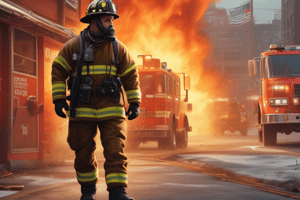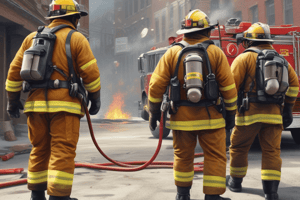Podcast
Questions and Answers
What information should NOT be transmitted over the radio when reporting an injury?
What information should NOT be transmitted over the radio when reporting an injury?
- Address of the incident
- Apparatus identification
- Time of injury
- Name of the affected firefighter (correct)
Who is responsible for notifying the on-call Division Commander in case of an injury?
Who is responsible for notifying the on-call Division Commander in case of an injury?
- JHSC Management Co-Chair
- Platoon Chief (correct)
- District Chief
- Communications Centre
Who is responsible for arranging immediate first aid treatment and transportation to a medical facility for an injured firefighter?
Who is responsible for arranging immediate first aid treatment and transportation to a medical facility for an injured firefighter?
- District Chief
- Communications Centre
- Platoon Chief
- Officer(s)/Supervisor(s) (correct)
What should the officer attending the hospital where the injured member is transported NOT be wearing?
What should the officer attending the hospital where the injured member is transported NOT be wearing?
What is the primary purpose of an injury, accident or incident investigation?
What is the primary purpose of an injury, accident or incident investigation?
Who investigates all significant injuries and near miss incidents occurring to TFS personnel?
Who investigates all significant injuries and near miss incidents occurring to TFS personnel?
What should be done with the scene of a significant injury or incident until released by the CJHSC Management Co-Chair or designate?
What should be done with the scene of a significant injury or incident until released by the CJHSC Management Co-Chair or designate?
What is the role of the JHSC Labour Co-Chair/member or designate in the case of an injury?
What is the role of the JHSC Labour Co-Chair/member or designate in the case of an injury?
Who is primarily responsible for gathering information about the incident from all TFS personnel?
Who is primarily responsible for gathering information about the incident from all TFS personnel?
What is the main objective of the investigation?
What is the main objective of the investigation?
Which of the following is NOT considered a significant injury?
Which of the following is NOT considered a significant injury?
What is the primary concern following a TFS member experiencing a significant injury?
What is the primary concern following a TFS member experiencing a significant injury?
Which of the following is NOT a requirement for reporting a near miss incident?
Which of the following is NOT a requirement for reporting a near miss incident?
What is the definition of a near miss for the purpose of CJHSC investigations?
What is the definition of a near miss for the purpose of CJHSC investigations?
Who should be contacted following a near miss incident?
Who should be contacted following a near miss incident?
What is the classification of a critical injury?
What is the classification of a critical injury?
Which of the following actions is NOT required immediately following a significant injury?
Which of the following actions is NOT required immediately following a significant injury?
What is the primary duty of the Officer/Supervisor managing a significant injury or near miss incident?
What is the primary duty of the Officer/Supervisor managing a significant injury or near miss incident?
Which of the following is an example of a significant injury according to the given text?
Which of the following is an example of a significant injury according to the given text?
What is the purpose of isolating and preserving the scene of an accident?
What is the purpose of isolating and preserving the scene of an accident?
What is the main purpose of an investigation in this context?
What is the main purpose of an investigation in this context?
What is the role of the respective District Chief in the investigation process?
What is the role of the respective District Chief in the investigation process?
Who is responsible for determining if an injury is critical when it happens off-duty?
Who is responsible for determining if an injury is critical when it happens off-duty?
What document is used to report an off-duty work-related injury?
What document is used to report an off-duty work-related injury?
Which of these is NOT an authorized action for the investigator(s) or investigation team?
Which of these is NOT an authorized action for the investigator(s) or investigation team?
What is the purpose of the "S-CRIT" SOG mentioned in the document?
What is the purpose of the "S-CRIT" SOG mentioned in the document?
How are investigation reports distributed?
How are investigation reports distributed?
What is the primary focus of the investigation regarding an accident?
What is the primary focus of the investigation regarding an accident?
What is the purpose of documenting and reporting a work-related injury, even if it occurs off-duty?
What is the purpose of documenting and reporting a work-related injury, even if it occurs off-duty?
Which of these is NOT a primary goal of an investigation into an injury or accident?
Which of these is NOT a primary goal of an investigation into an injury or accident?
What is meant by a workplace accident?
What is meant by a workplace accident?
Which of the following is NOT considered a critically injured individual?
Which of the following is NOT considered a critically injured individual?
Who is responsible for managing an incident involving workplace injuries?
Who is responsible for managing an incident involving workplace injuries?
What classification applies when an employee experiences a fracture to their femur?
What classification applies when an employee experiences a fracture to their femur?
Which of these conditions would classify an injury as critical?
Which of these conditions would classify an injury as critical?
What does an injury resulting from occupational disease imply?
What does an injury resulting from occupational disease imply?
Which of the following statements is accurate regarding injuries that lead to unconsciousness?
Which of the following statements is accurate regarding injuries that lead to unconsciousness?
What is NOT a responsibility of the supervisor in case of an accident?
What is NOT a responsibility of the supervisor in case of an accident?
Which of the following is an example of a critical injury?
Which of the following is an example of a critical injury?
Which of the following injuries is classified under critical injuries according to underlying medical conditions?
Which of the following injuries is classified under critical injuries according to underlying medical conditions?
Flashcards
Workplace accident
Workplace accident
Any unplanned event that results in damage, injury, illness, or death while performing work tasks.
Injury (workplace)
Injury (workplace)
Any physical or functional issues caused by work-related events or illnesses.
Critically injured
Critically injured
A serious injury causing potential life-threatening risk, unconsciousness, or severe blood loss.
Critical Injury (Loss of Consciousness)
Critical Injury (Loss of Consciousness)
Signup and view all the flashcards
Critical Injury (fractures)
Critical Injury (fractures)
Signup and view all the flashcards
Critical Injury (Amputation)
Critical Injury (Amputation)
Signup and view all the flashcards
Critical Injury (Burns)
Critical Injury (Burns)
Signup and view all the flashcards
Critical Injury (Vision Loss)
Critical Injury (Vision Loss)
Signup and view all the flashcards
Supervisor's Responsibility (Accident)
Supervisor's Responsibility (Accident)
Signup and view all the flashcards
Critical Injury Procedures
Critical Injury Procedures
Signup and view all the flashcards
Purpose of an Investigation
Purpose of an Investigation
Signup and view all the flashcards
Who Starts the Investigation?
Who Starts the Investigation?
Signup and view all the flashcards
Finding Facts, Not Fault
Finding Facts, Not Fault
Signup and view all the flashcards
Who Investigates Significant Incidents?
Who Investigates Significant Incidents?
Signup and view all the flashcards
Scene Preservation
Scene Preservation
Signup and view all the flashcards
Emergency Notifications
Emergency Notifications
Signup and view all the flashcards
Hospital Attendance Requirement
Hospital Attendance Requirement
Signup and view all the flashcards
Division Commander Notification
Division Commander Notification
Signup and view all the flashcards
Treatment and Transportation
Treatment and Transportation
Signup and view all the flashcards
Injury Information Report
Injury Information Report
Signup and view all the flashcards
Significant Injury
Significant Injury
Signup and view all the flashcards
Near Miss
Near Miss
Signup and view all the flashcards
Primary Concerns after an Accident
Primary Concerns after an Accident
Signup and view all the flashcards
Reporting Significant Injuries and Near Misses
Reporting Significant Injuries and Near Misses
Signup and view all the flashcards
Communications Centre
Communications Centre
Signup and view all the flashcards
Officer/Supervisor
Officer/Supervisor
Signup and view all the flashcards
Witness Report
Witness Report
Signup and view all the flashcards
Officer/Supervisor of the Injured Worker
Officer/Supervisor of the Injured Worker
Signup and view all the flashcards
Toronto Fire Services Injury/Near Miss Observation Form
Toronto Fire Services Injury/Near Miss Observation Form
Signup and view all the flashcards
Standard Operating Guideline
Standard Operating Guideline
Signup and view all the flashcards
Incident Investigation
Incident Investigation
Signup and view all the flashcards
Purpose of Incident Investigation
Purpose of Incident Investigation
Signup and view all the flashcards
Off-Duty Injury
Off-Duty Injury
Signup and view all the flashcards
Off-Duty Injury Reporting
Off-Duty Injury Reporting
Signup and view all the flashcards
On-duty Platoon Chief Duties
On-duty Platoon Chief Duties
Signup and view all the flashcards
Supervisor's Report
Supervisor's Report
Signup and view all the flashcards
Investigation Team Powers
Investigation Team Powers
Signup and view all the flashcards
Requesting Tests and Reviews
Requesting Tests and Reviews
Signup and view all the flashcards
Distribution of Investigation Reports
Distribution of Investigation Reports
Signup and view all the flashcards
Remedial Actions
Remedial Actions
Signup and view all the flashcards
Study Notes
Accidents in the Workplace (Non-Vehicular)
- Purpose: This procedure outlines the investigation of workplace injuries, accidents, and incidents.
- Responsibility: Supervisors are responsible for injured personnel, incident classification, and appropriate action.
- Critical Injury Note: See OG S-CRIT for critical injuries to Toronto Fire Services (TFS) personnel or the public. Ensure all specified actions are followed.
- Workplace Accident Definition: An unplanned event causing property damage, unintended injury, illness, or death during employment.
- Injury Definition: Physical or functional abnormality or loss resulting from a workplace event or occupational illness, potentially involving lost time or need for medical attention.
- Critically Injured Definition: Injuries with a serious nature that produce unconsciousness, jeopardize life, cause substantial blood loss, involve fractures of a leg or arm (not fingers/toes), amputations (except fingers/toes), major body burns, or loss of sight in one eye. Additional critical injuries can include fractures to the ankle, wrist, kneecap, multiple finger or toe fractures, or amputations of more than one finger or toe. More than one finger or toe fracture or amputation may be a critical injury. Examples are listed in the guide.
- Near-Miss Definition: A situation avoided a critical injury or fatality, frequently involving failure of personal protective equipment. A near miss requires reporting to the appropriate supervisor.
Immediate Actions of Officers
- Primary Concern: Immediate healthcare for the injured, ensuring no additional injuries, and accurate incident documentation.
- Scene Isolation (Preserve): Isolate and preserve the scene to assist with identifying the causes.
- Incident Notification (Communications): Notify the relevant communications officer (phone, radio).
- Incident Information Requirements: Provide information about the incident (type, location, time, names of affected personnel if necessary), identifying details, safety and equipment aspects, and names of additional witnesses.
- Reporting Procedures (Documentation): Fill out required forms (i.e., Supervisor's Report of Injury/Accident).
- Witness Identification: Obtain contact information from any witnesses.
Treatment and Transportation
- First Aid: Secure immediate first aid treatment and transport to a medical facility (necessary).
- District Chief: Ensure a District Chief of the appropriate district is present/attending the hospital for the injured personnel being transported.
- Protective Equipment Restrictions: Ensure the responding officer is not wearing bunker gear or other protective gear upon arrival at the hospital.
Investigation
- Purpose: Discovering underlying causes to prevent future incidents.
- Initiation: Responsibility falls to the immediate supervisor.
- Nature: Fact-finding, not blame-placing.
- Necessary Information Gathering (Investigator): Document the incident's circumstances, gather data from witnesses, review reports, examine scenes and equipment.
WSIB Reporting (Lost Time Off-Duty)
- Off-Duty Injury Reporting: An employee discovering an off-duty injury should immediately report it.
- Medical Attention: The employee should seek appropriate medical attention.
- On-Duty Notification, Platoon Chief: Report the injury to the on-duty Platoon Chief while off-duty.
- Critical Injury Determination: The on-duty Platoon Chief has to assess the nature of the injury (critical vs. non-critical)
- Reporting Process: Proper completion of supervisor's report by the appropriate party.
Related SOGs
- S-CRIT: Critical injuries to Toronto Fire Services personnel and the public.
Studying That Suits You
Use AI to generate personalized quizzes and flashcards to suit your learning preferences.





